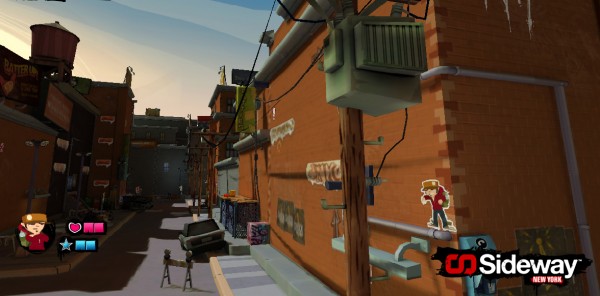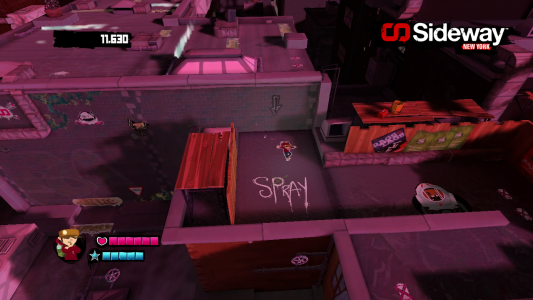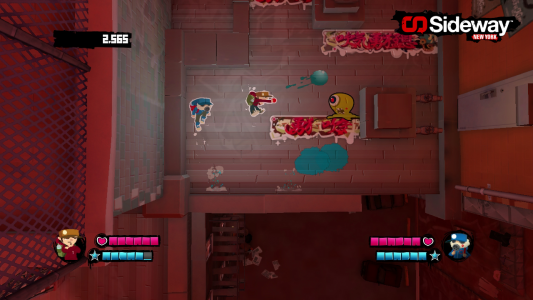Also on: PC
Publisher: Playbrains
Sony Online Entertainment
Developer: Playbrains
Fuel Industries, Inc.
Medium: Digital Download
Players: 1-2
Online: Leaderboards, DLC
ESRB: E10+
Ever since game developers realized that geometry was still interesting and that they could play with things like shapes and angles, we’ve been living in a world where 2D and 3D games have been at war with each other. Rarely are these dimensions not vying for attention over each other, but occasionally their powers combine to produce an interesting game like Echochrome, or Echochrome II, or Super Paper Mario, or Super Mario 3D Land, or Fez, or Crush, or Crush 3D, or uhhhhhhhhh..
With so much variety, it’s easy to see how this is a combination that’s hard to break new ground with– this genre of 2D+3D, or 5D as logic would conclude. Gamers are the winner, however, as the massive bandwagon encourages developers to forge an identity that will stand out from the crowd– one that is generally interwoven with a novel gameplay mechanic. Most of the time they’re perspective-based puzzles, but Playbrains wasn’t going to have any of that nonsense when creating Sideway: New York. What came forth instead was a 5D platformer with a twist of perspective-based jumping, for better or worse.
 Players are lead through the NY transit system as Nox, which I think is short for noxious, a once-3D tagger who is flattened onto the 2D layer of some buildings with animated graffiti monsters on them. Unsure of why he’s been turned into a lesser form of animation, his only goal is to defeat Spray, another cartoon who wants to escape the world of art and become a video game character on modern consoles in 3D.
Players are lead through the NY transit system as Nox, which I think is short for noxious, a once-3D tagger who is flattened onto the 2D layer of some buildings with animated graffiti monsters on them. Unsure of why he’s been turned into a lesser form of animation, his only goal is to defeat Spray, another cartoon who wants to escape the world of art and become a video game character on modern consoles in 3D.
Remember when I said that this 5D game may have been conceived for better or worse? I had a reason for that. While the 5D effect of following 3D geometry around corners of buildings which displays all interactive elements, things to collect, and enemies on a 2D plane is an interesting showpiece for aesthetics in games, it’s also self-defeating at times. As much as I like games that can be a pain in the ass to play, I only like it when they’re designed that way. Sideway: New York’s big problem is that the camera isn’t showing enough of an area to give information to the player about what to expect. I found myself hating the act of navigating interior corners since there would oftentimes be a deathtrap waiting on the other side of a 90-degree angle that hadn’t been revealed until I actually leapt out.
 Normally this would be funny, but I don’t think S:NY has thought far enough ahead to take joy in killing players for blindly traversing portions of the game’s 5D world. I actually think this was an inside joke they forgot to take out.
Normally this would be funny, but I don’t think S:NY has thought far enough ahead to take joy in killing players for blindly traversing portions of the game’s 5D world. I actually think this was an inside joke they forgot to take out.
Exterior corners don’t share as frequently this issue, but that doesn’t mean it’s exclusive only to one type of perspective shift. This, next to enemy hitboxes that are ill-defined and platform that is too floaty for the game that Sideway:New York wants to be, is bringing down a game that looks interesting from a distance. I was sad to get my paws on the final product to play a game that is making an effort to break a mold, but not firmly grasping its own concept.
It’s not until the final act of the game that the levels finally find their rhythm and the controls interact properly with the game mechanics and level design. In order to make sure it wasn’t just me finally understanding the whack physics, I went back to replay the earlier levels and discovered not only was I right, but that they were even less fun knowing that the game’s strong point made the weak ones suck harder. Not to mention, the boss fights are at the same time both incredibly easy and entirely frustrating. You’ll either breeze through an area’s final confrontation, or end up trapped against a wall or defeated by erratic enemy movements that outpace your own abilities. That goes for every boss, including an endgame battle that couldn’t have left a worse last impression for the title.
 Sideway could even stand to have some of the fat trimmed, with all the elements it borrows from other 2D platformers. There are bits of Mario, Donkey Kong, and even Castlemetroidia combat within the scope of its few hours, but none serve any meaningful purpose that can’t be achieved outside of punching or jumping on an enemy to death. More successful, however, are the environmental triggers that allow access to hidden areas, which are thankfully used on a regular basis to spice up platforming segments.
Sideway could even stand to have some of the fat trimmed, with all the elements it borrows from other 2D platformers. There are bits of Mario, Donkey Kong, and even Castlemetroidia combat within the scope of its few hours, but none serve any meaningful purpose that can’t be achieved outside of punching or jumping on an enemy to death. More successful, however, are the environmental triggers that allow access to hidden areas, which are thankfully used on a regular basis to spice up platforming segments.
Other things to complain about are the shitty collaboration with Skullcandy and the lifeless tracks accompanying the areas in Sideway. I might just have quit playing if the game was any longer than the evening it lasted. Rarely does poor sound design stand out since so many games drop the ball with it, but Sideway actually feels like it goes to lengths in order to assure you’re bored on multiple levels alongside gameplay and color palette.
While 5D games are all the rage right now, Sideway: New York serves as an example on what happens to a concept that stumbles out of the gate. It’s not a horrible game by any means, but it’s certainly not a fully realized idea based on what’s been shown in this first of three titles. Hopefully the potential for a tightly wound action platformer is reached within the next release, because all that we’ve been given at this point is a well-animated bunch of 2D assets hopping around a drab collection of 3D boxes.

